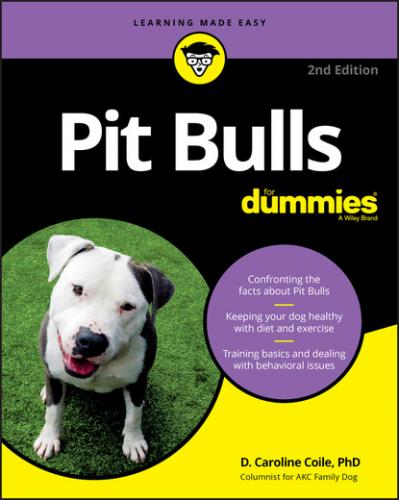The truth is in the middle. No family of dogs comes close to being responsible for as many deaths as the Pit Bull has been. These deaths include human and canine family members and human and canine strangers. The attacks are committed by both well-raised and poorly raised Pit Bulls. But that doesn’t mean every Pit Bull is a mauler. In fact, most go through their entire lives being perfectly peaceful.
MAKING A NEW BREED: THE AMERICAN BULLY
In the early 1980s, several breeders began crossing American Pit Bull Terriers or American Staffordshire Terriers with Staffordshire Bull Terriers along with English Bulldogs, American Bulldogs, Olde English Bulldogges, and French Bulldogs. Their aim was to create a tougher-looking but sweeter-acting bully breed: the American Bully. By 2004, they had their own association, the American Bully Kennel Club (ABKC).
The breed has four sizes: pocket, standard, classic, and XL. The UKC recognized the American Bully in 2013. As of this writing, you can single-register your dog with the UKC if it looks enough like an American Bully to probably be one. (Single registration means the dog is registered based on its appearance rather than parentage.) This rule has caused controversy, however, because some Pit Bull owners who don’t want the legal implications of Pit Bull ownership have single-registered their Pit Bulls as American Bullies. By doing so, they may be able to get around BSL that affects Pit Bulls but may not include American Bullies.
Chapter 2
Sizing Up the Pit Bull
IN THIS CHAPTER
You wouldn’t hire a Sumo wrestler to moonlight as a trapeze artist, and you wouldn’t ask a ballet dancer to do double duty as a weightlifter. Different body types excel at different athletic endeavors. It’s no accident that Pit Bulls look like Pit Bulls. They look like they do because they are built a certain way to do a certain job.
But looks aren’t everything. The best-looking Pit Bull would, historically at least, be a dead Pit Bull if he lacked the intelligence, agility, and gameness required to make it through a match. Although, fortunately, most Pit Bulls today will never see a fighting pit, they carry with them a heritage of physical and mental characteristics that were once essential for their ancestors’ survival.
Now that most Pit Bulls are no longer subject to such an unforgiving means of selecting breeding stock as pit fighting or bull-baiting, how do we ensure that the very essence of this noble breed is not lost for posterity? We do the best we can by breeding them according to a standard of perfection that — as nearly as possible — aspires to the ideal vision of a successful fighting Pit Bull.
Toughing It Out
Because dog fighting is no longer condoned in our society, the Pit Bull is among those breeds that can no longer prove its merit by performance. This doesn’t mean that the Pit Bull will die out, nor does it mean that we should let it. The goal of preservationist breeders is to preserve both the physical and the mental aspects of purebred dogs, even if their original function no longer exists. The Pit Bull is a noble breed, a breed that provides a unique link to our own heritage (see Figure 2-1). As such, it is a sort of living antique — one that must be re-created with every generation. We can look to the fighters of the past as models by which to judge the Pit Bulls of today and by which to create the Pit Bulls of tomorrow.
FIGURE 2-1: You can’t deny the noble look of this dog.
What did it take to win a dogfight? For the most part, it took intangible character qualities like gameness and attitude. In addition, it took wrestling ability, biting ability, and stamina — qualities based (at least in part) on the way the dog is built. Because a fighting dog is more likely to overcome shortcomings in build rather than shortcomings in character, the physique of winning fighters varied greatly from one dog to another. Nonetheless, the best of the fighters combined strong characters with strong bodies, and it is from these dogs that the ideals are drawn.
Building a Better Bulldog
The standards of the American Dog Breeders Association (ADBA) and the United Kennel Club (UKC) for the American Pit Bull Terrier differ in many respects. In turn, the standard of the American Kennel Club (AKC) for the American Staffordshire Terrier differs from those of the ADBA and the UKC. Yet each organization describes a dog who is built to win a fight — and a good dog should be a good dog, no matter by which standard he is judged.
The American Dog Breeders Association standard
The ADBA standard was written by experienced dogmen (people who actually fought their Pit Bulls in dogfights) who realized that it was impossible to define the physical traits that make a dog a good fighter. Instead of trying to describe every part of the dog, as most breed standards do, they focused their descriptions on those physical characteristics that they felt related the most to fighting ability, while ignoring those they felt had little or no relationship. Thus the ADBA standard is less a standard of perfection than it is a checklist for evaluating a potential fighting dog.
The ADBA standard evaluates the American Pit Bull Terrier on a basis of 100 points (100 points equaling the ideal dog) that are broken down as shown in Table 2-1.
TABLE 2-1 The ADBA Breed Standard
| Category | Point Value | Criteria |
|---|---|---|
| Overall appearance | 20 points | Health, height-to-weight ratio, overall body shape |
| Attitude | 10 points |
